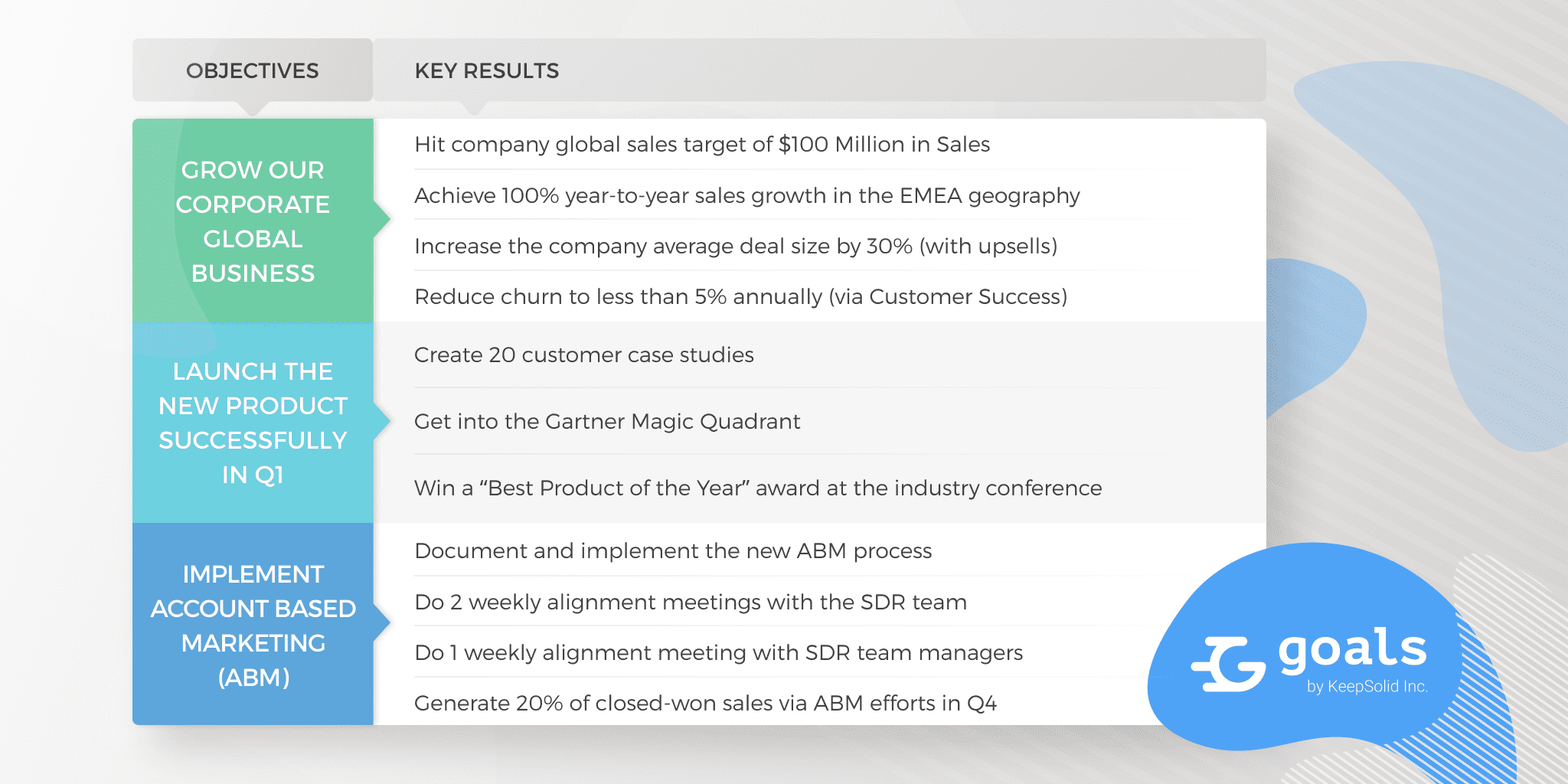How to choose goals and objectives? The short answer is - in a way so that they point your business in the direction you want it to move, and keep it on the right track. That’s why any successful company needs to make a business goal statement - a concise description of what your organization does, why it does it, and how.
A business goal statement is a relevant consideration for any entrepreneur. A clear vision and statement of the company’s objectives and purpose are key for its success. In this piece, the KeepSolid Goals team will take a look at how to establish a business goal statement and some examples of strategic business objectives.
What is a Business Goal
First things first, let’s start with the basics and define a business goal. There is a great framework called OKR that will help us figure it out. OKR stands for Objectives and Key Results, and it consists of the following aspects:
- Objective - it’s your business goal, something that you want your organization to achieve in a given period. Objectives should be actionable, time-bound, and qualitative. But most importantly, they must be ambitious and not overly specific - they should form a grand overarching target for your business to aim at, not a concrete roadmap. Objectives tell you where you want to go.
- Key Results - these are the sub-goals that will get you closer to your Objective. Define 2-4 Key Results per Objective. They should facilitate your business goals, cover the things you need to accomplish to reach the Objective. Key Results are usually based on revenue, performance, growth, or engagement. Key Results tell you how to get where you want to go.
- Tasks - these are the particular specific activities that must be performed by specific employees and teams to reach the Key Results.

OKR is a great framework for goal setting because it gives you a concrete guideline to base your business goal statement upon. That’s why our business planning and project management app KeepSolid Goals is built around this concept and facilitate the OKR philosophy.
Approaches to Creating a Business Goal Statement
1. Tying business goals to the mission statement
If your business already has a mission statement, it would be an obvious first choice to get ideas for your business goals. Review your company’s mission statement and use some key phrases from it to define your major business goals.
For example, let’s say your company’s mission is to ”build a reputation among local customers as the most reliable and friendly retailer”. This statement can be split into three business goals (Objectives), each with its set of Key Results:
- “Build a reputation” - increase brand awareness
- Create a customer referral program
- Send monthly newsletter
- “Reliable” - enhance staff expertise
- Schedule staff training sessions
- Have all staff certified
- “Friendly” - improve customer service
- Hire more employees
- Track customer satisfaction score

2. Business goal statement with the ACES
Most often business objectives will define a positive outcome that you want your company to achieve. However, occasionally it may be reasonable to state goals based on the pitfalls that you want to avoid, or the weaknesses to eliminate. For such cases, using an acronym ACES for business goal statement might be an option:
- Achieve: What do you want to reach? (e.g. second round of venture capital)
- Conserve: What do you want to maintain? (e.g. employee morale)
- Eliminate: What do you want to drop? (e.g. unnecessary expenditures)
- Steer clear: What do you want to avoid? (e.g. losing high-performing employees)
3. Business goal statement as a checklist
Finally, you can create a checklist as your business goal statement, split into five categories of objectives:
- Day-to-day work goals - what your company does every day (order tracking, customer follow-up, office management, etc.) Goals that fall into this category should be about something that will make a difference in your business’ day-to-day effectiveness.
- Problem-solving goals - these address specific business challenges that you confront (quality of service issues, low employee morale, etc.)
- Development goals - these are all about acquiring new expertise or skills (for your employees or yourself).
- Innovation goals - innovative approaches that will make your organization more effective (in what new ways can you improve your company’s products or services, your business marketing, or your distribution and delivery?)
- Profitability goals - at the end of the day, your bottom line is what matters for any business, and this category of goals show where you want your profit to be.
SMART business goals
And whatever you choose, don't forget to keep your business goals SMART!

Examples of Strategic Business Goal Statements
Financial business goal examples
- Grow shareholder value (increase the value of your organization for your stakeholders and owners)
- Increase revenue (either the overall revenue or that from a key area of your business)
- Maintain appropriate financial leverage (a.k.a. stay within an optimal amount of debt)
- Ensure financial sustainability (e.g. managing costs or seeking outside sources of revenue if your business is working in an uncertain economic environment)
Customer business goal examples
- Best value for the cost (customers know that with your company they are getting the best deal)
- Reliable products/services (be it the dependable reliability of a printer with high-quality output or the on-time reliability of an airline)
- Increase share of market (selling to more customers)
- Increase share of wallet (selling more to the same customers)
Learning & growth business goal examples
- Improve technical and analytical skills (either a specific skill or a broader set of skills necessary for the job)
- Establish a performance-focused culture (that focuses more on incentives and performance management)
- Attract and retain high-performing employees (who you need to hire, how many, and how to retain them)
- Develop leadership potential of the team (grow good leaders instead of hiring them)
Internal business goal examples
- Product and service innovation (constant and cutting-edge innovation in chosen areas)
- Grow percentage of sales from new products (to ensure that even as your current products’ life cycle comes to a close, you will have new ones that will sustain your business)
- Improve customer service (set the standard for customer service quality and communicate it internally)
- Reduce waste by a certain amount (can result in significant cost savings if your company uses a lot of raw materials)
Set business goals with KeepSolid Goals!



